Art World
Crystal Bridges Curator Mindy Besaw Shares 7 Unmissable Works From the Museum’s Landmark New Show of Native Art
The show looks at indigenous art from the 1950s to the present.
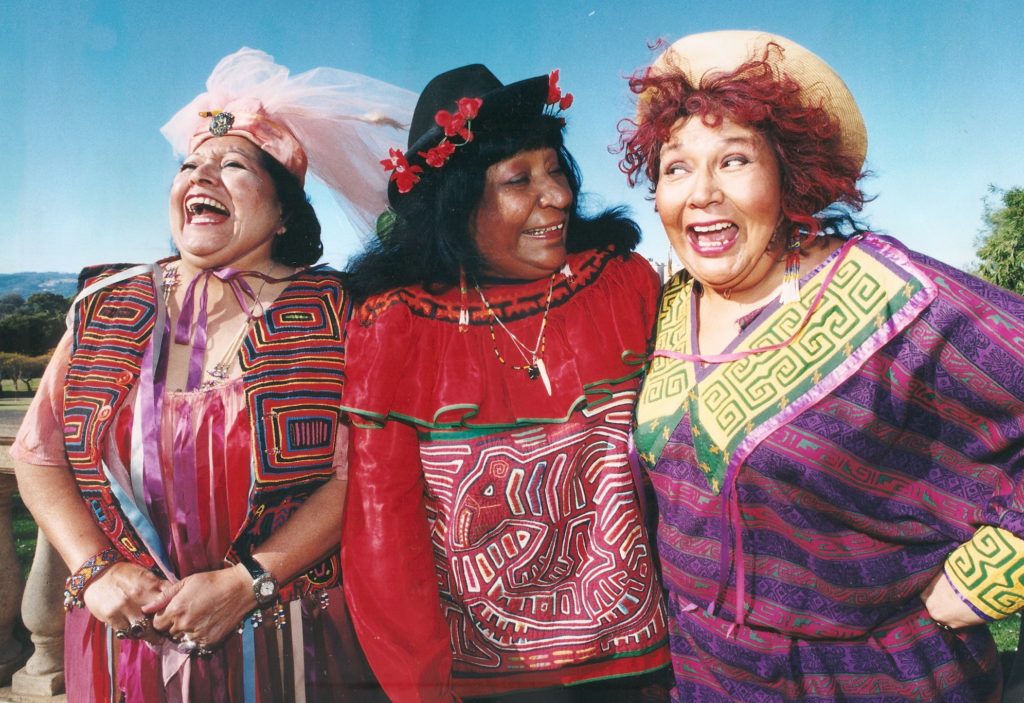
The show looks at indigenous art from the 1950s to the present.

The current exhibition “Art for a New Understanding: Native Voices, 1950s to Now” at Crystal Bridges Museum in Bentonville, Arkansas, is a serious attempt to redefine what contemporary Indigenous art means today. Highlighting the work of 40 Indigenous artists from the US and Canada from the 1950s to the present, the show examines ways each of the artists are part of a larger dialogue about contemporary Native art’s correspondence with the broader contemporary art world.
“We’re hoping the exhibition leads to a new understanding of what contemporary Indigenous art is,” said Mindy Besaw, who curated the show along with independent curator Candice Hopkins (Carcross/Tagish First Nation) and Manuela Well-Off-Man, who is now is the chief curator at the Museum of Contemporary Native Arts at the Institute of American Indian Art, but conceived of the exhibition when she still worked at Crystal Bridges. “We are trying to take a really broad examination: What is the quality of the piece? How does it move the conversation forward? How has it helped us reconsider Native art or contemporary art more broadly?”
We spoke with Besaw about some of the standout works from the show, which will travel starting in January 2019 to the Institute of American Indian Art, followed by the Nasher Museum of Art at Duke University, and the Memphis Brooks Museum of Art.
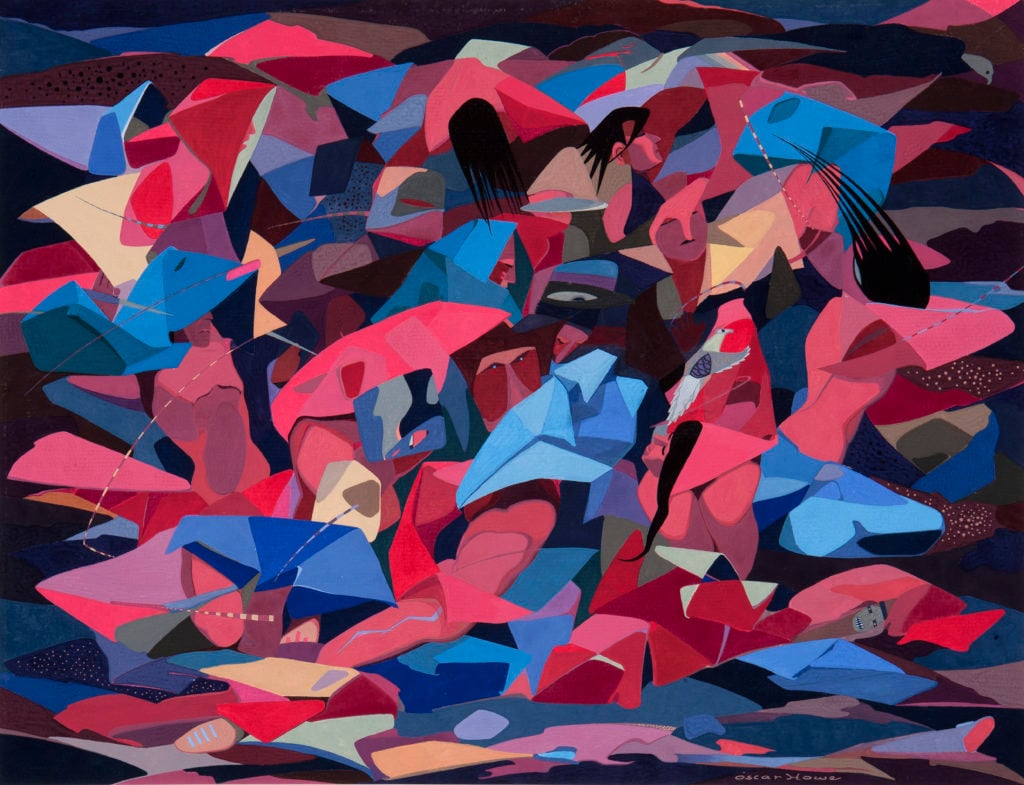
Oscar Howe, Dance of the Heyoka (ca. 1954). Philbrook Museum of Art, Tulsa, Oklahoma. © 2018 by permission of the Oscar Howe Family.
“The figure that seems to be moving through the whole space could be interpreted as a larger dance with multiple figures, or one figure—the Heyoka—moving throughout,” Besaw says. “What we are trying to say is that abstraction is not just a European modern art convention. Dakota art, for example, would have had a lot of abstraction in beadwork or other art. It’s not necessarily that you take a cultural subject and apply this early modernism to it. This is a way of him blending his cultural background and something specific to a traditional dance in Dakota traditions.”
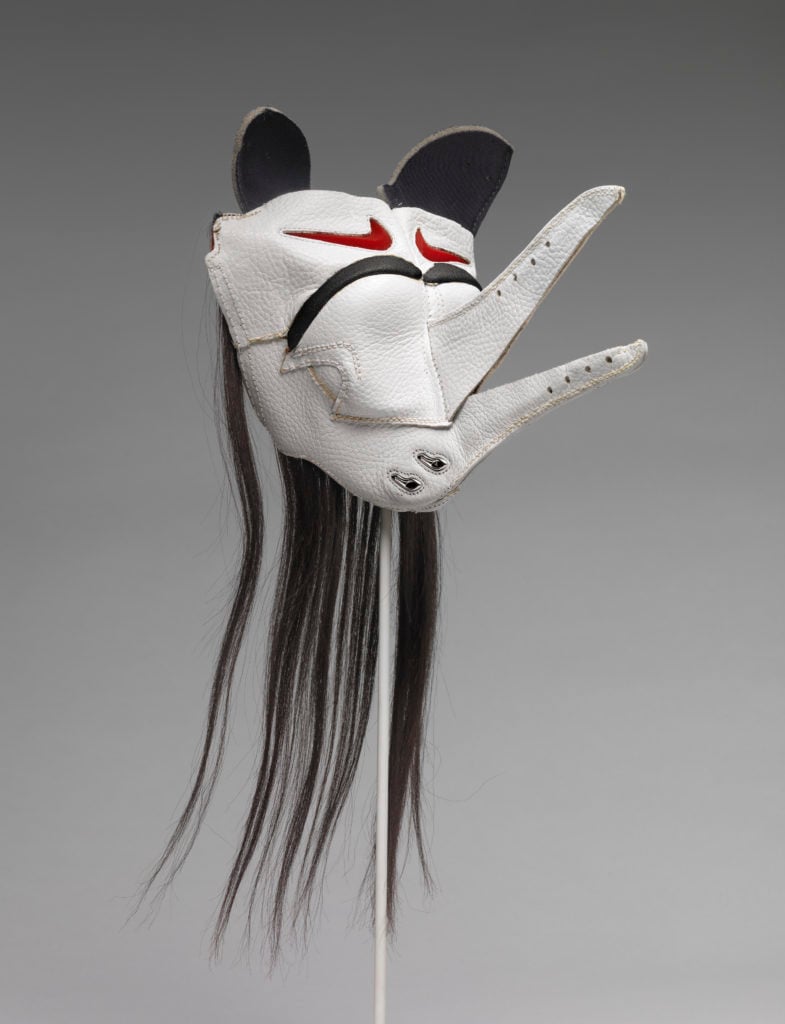
Brian Jungen, Prototype for New Understanding #2 (1998). The Vancouver Art Gallery. Photo: Trevor Mills, Vancouver Art Gallery.
“This piece prompted our show’s title. His title for the series, ‘Prototypes for New Understanding,’ came from treaty language. This is the second in a series of 23 sculptures made of Nike Air Jordans. In the 1990s, Jungen was working in New York and had gone to the Nike store that had newly opened and noticed that the Nike Air Jordans were displayed in these vitrines as precious objects.
At the time, Northwest Coast imagery had started to stand for all First Nations individuals in Canada, which of course is a misnomer that one style would be all of the different groups. He was noticing some of the similarities with the color—the black, red, and white in the Nike Air Jordans, and also similarities in how they were displayed. He was seeing parallels in commodification of products and culture.”
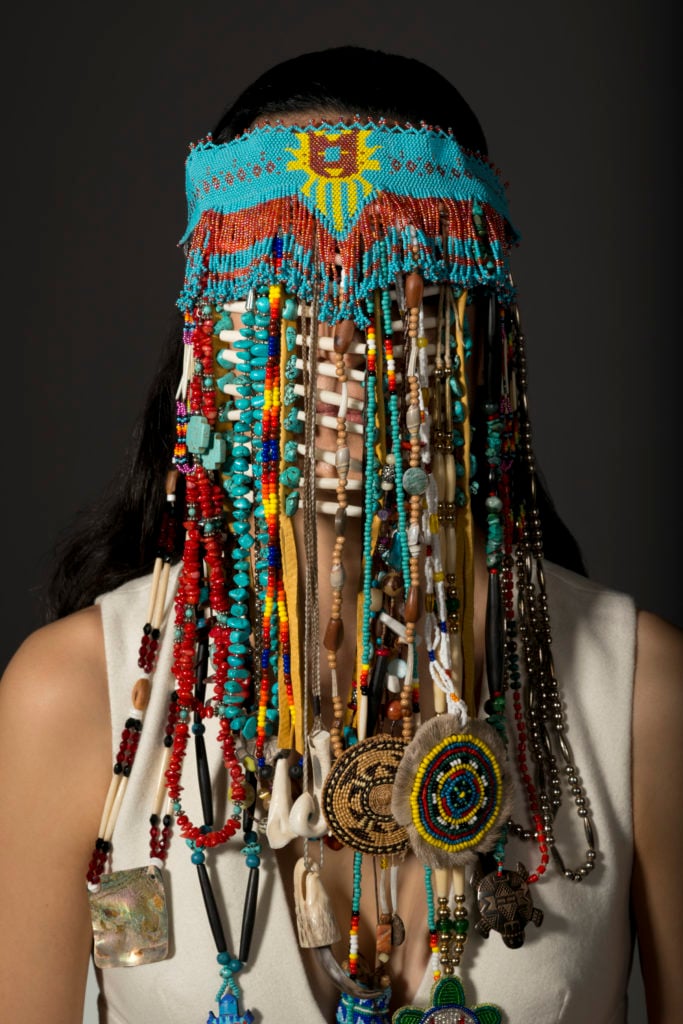
Dana Claxton, Headdress (2015). © Dana Claxton.
“This headdress feels very veil-like,” Besaw says. “She’s both confronting the viewer as well as masking the wearer of this piece, so it’s an interesting relationship with the viewer itself. She is asking: Who can wear something like this? What is the cultural background that this comes from? Should we pay a little bit more attention to where these things originate? She’s hoping to raise probably more questions than answer them.”
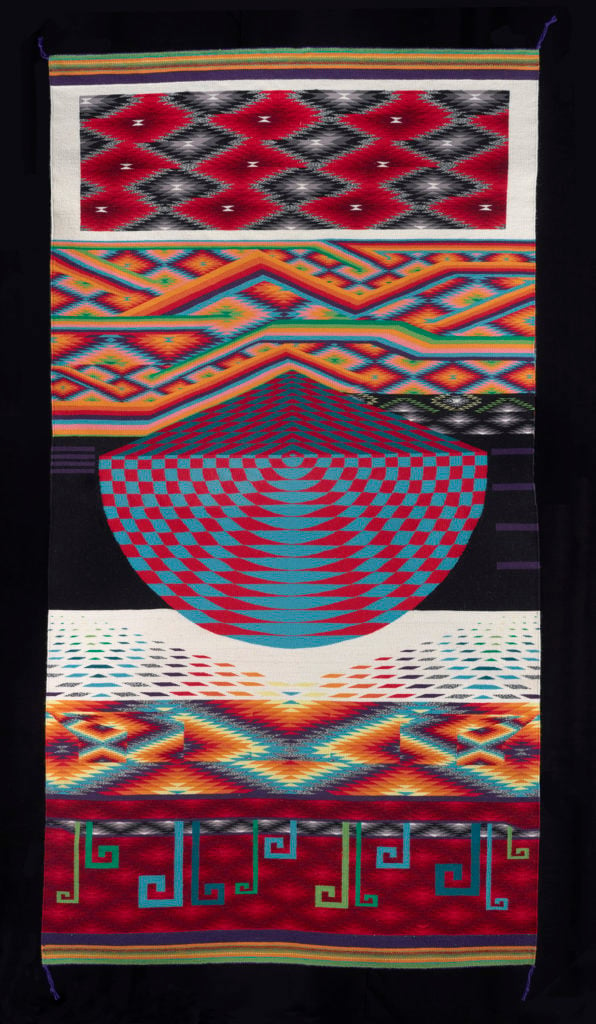
Melissa Cody , World Traveler (2014). Stark Museum of Art, Orange, TX. Courtesy of the artist.
“Melissa Cody is a fourth, maybe even a fifth generation Navajo weaver, and she’s using and referencing certain motifs and styles that have been used for Navajo weaving for generations and generations,” Besaw says. “What we were really saying with this is: It’s not a debate over traditional or contemporary. They are contemporary living today, but that one of the constants in Native American life and Navajo is an example is innovation. For example, during the Long March, the Navajo people were removed from their land by Kit Carson and the military, who slaughtered their sheep so they didn’t have the wool they would have normally made for weaving. They instead were given manufactured Germantown blankets from Pennsylvania. The Navajo would unravel them and then use that yarn to make their own patterns. So even in the face of changing ways of life and conditions, they were able to innovate and use the materials that they had to carry a tradition forward.”
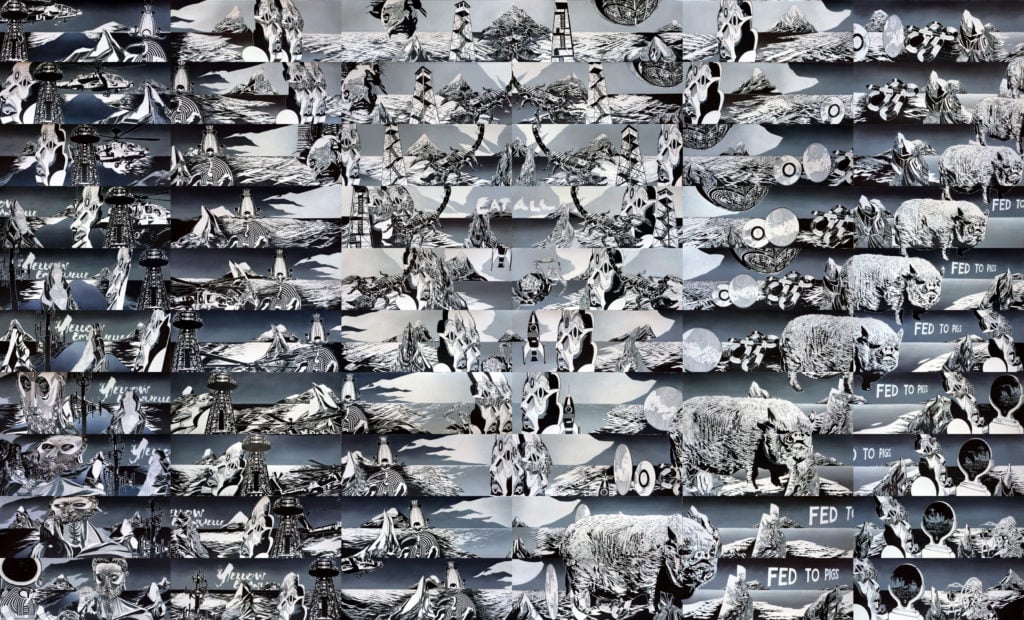
Andrea Carlson, Ink Babel (2014). Courtesy of the Artist and Bockley Gallery, MN. © Andrea Carlson.
“This consists of 60 different panels of paint and ink on paper that are then mounted directly onto the wall. They have a cinematic, almost photographic feel,” Besaw says. “She is intentionally referencing film strips, so some of the things seem to morph closer to us or fade away or rotate as they go through. The whole piece has that ‘v’ of an outline as a composition. As you look from left to right, as if they are strips, they seem to be moving up and down, but then the piece is organized across that horizon.
She is often thinking of encounters. One place you can really see this is at the bottom right, that orb shape that goes diagonal lower to upper on the right and the face that seems to be screaming. What’s reflected in the orb are ships, as if it’s Columbus—either arriving or departing, we’re not really sure.”
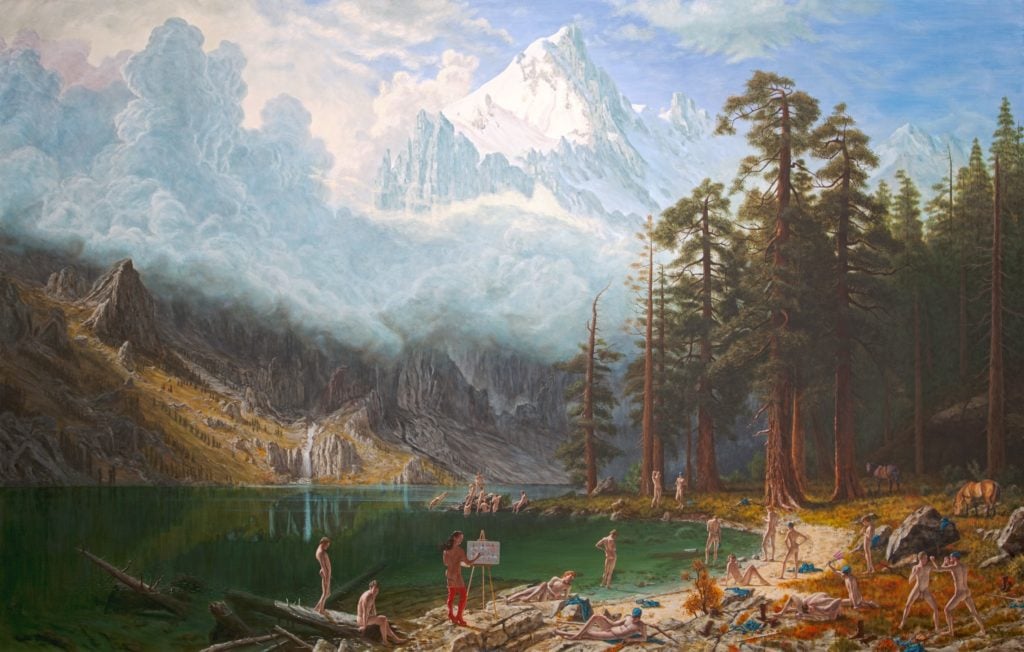
Kent Monkman, History is Painted by the Victors (2013). Denver Art Museum.
“He uses an Albert Bierstadt painting, Mount Corcoran, which is a pretty monumental painting, as a background,” Besaw says. “He’s populating the Albert Bierstadt landscape, which was completely unpopulated, and putting forward the idea of manifest destiny. ‘Go out west, these lands are empty,’ when in fact they weren’t.
In the foreground are all these little nude male figures, based on a Thomas Eakins painting, and studies that Eakins did of the human body. The men are meant to be Colonel Custer and his men right before the battle that we know of as the Battle of Little Big Horn—what the plains Indians called the Battle of Greasy Grass.
The figure wearing the thigh-high, high-heeled boots is Kent Monkman’s alter ego called Miss Chief Eagle Testickles. On the little easel there is almost like a leger style, or a style used on hide paintings, so he’s appropriating all these different things in this very humorous way of saying, ‘What would happen if the indigenous vantage point was prioritized?’
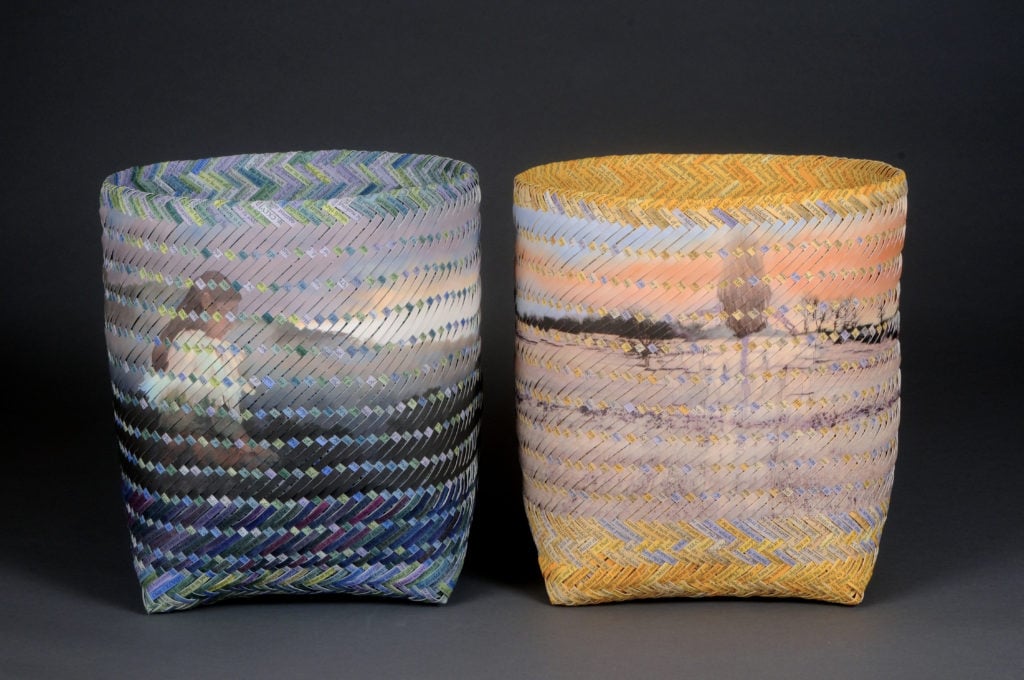
Shan Goshorn, Removal (Ancestral Homeland and
Oklahoma Indian Territory) (2012).
“Goshorn is an eastern band of Cherokee, so she thinks a lot about land and relationships to land, and especially something like removal, which still has very much influenced lives today,” Besaw says.
“These are double weaved baskets based on traditional Cherokee basket making. She learned how to do this at a job she had maybe just out of high school working for the Indian Bureau that was documenting historic basketry. She’s one of maybe a dozen people who have been recognized as being able to make these double weave baskets. She takes documents or photographs—sometimes maps or treaties, and slices them up. She’s transforming that document [in this case photographs] and reclaiming it through her act of transformation.”
“Art for a New Understanding: Native Voices, 1950s to Now” is on view through January 7 at Crystal Bridges, 600 Museum Way, Bentonville, Arkansas.